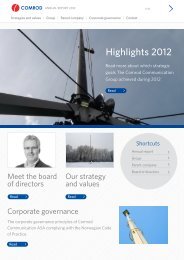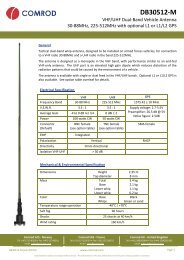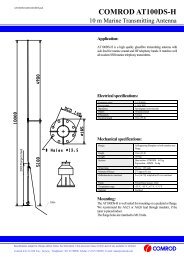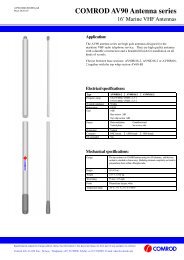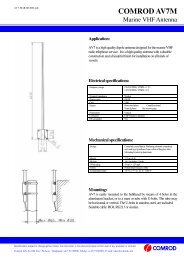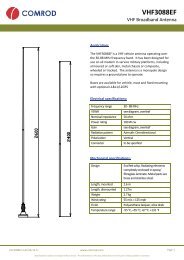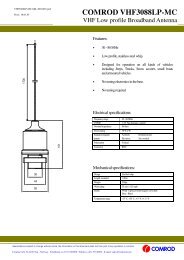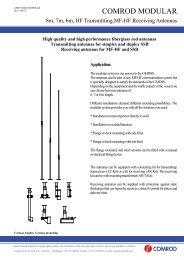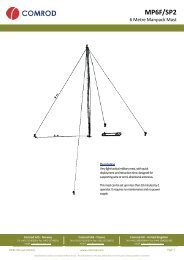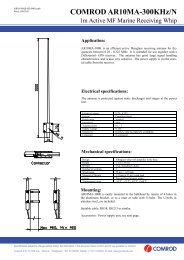Annual report 2008 - Comrod
Annual report 2008 - Comrod
Annual report 2008 - Comrod
- No tags were found...
Create successful ePaper yourself
Turn your PDF publications into a flip-book with our unique Google optimized e-Paper software.
ecognized, the excess is recognized in the balance sheet asgoodwill.All other investments are accounted for in accordance with IAS39, Financial Instruments – recognition and measurement.Intra-group transactions and balances, including internal earningsand unrealized profits/losses, are eliminated.2.4 Cash & cash equivalentsCash and cash equivalents consists of cash in hand and at bank.Any positive balances against bank overdrafts are includedas a component of cash and cash equivalents in the cash flowstatement. The cash flow statement has been prepared usingthe indirect method. In the balance sheet, bank overdrafts areincluded as short-term loans.2.5 Trade receivablesTrade receivables are recognized at historical cost less provisionfor bad debt.2.6 HedgingBefore any hedging transaction is undertaken, an assessmentis made as to whether a derivative (or in the case of currencyhedging another financial instrument) is to be used to hedge a)the fair value of an asset or liability in the balance sheet, b) futurecash flows from an asset or liability in the balance sheet, a veryprobable future identified transaction or, in the case of currencyrisk, a firm commitment or c) a net investment in a foreign entity.Hedge accounting ceases if:(a) the hedging instrument expires, terminated, exercised or sold,(b) the hedge does not satisfy the above hedging requirements,(c) or the group for other reasons chooses to discontinue hedgeaccounting.When hedge accounting ceases, changes in the balance sheetvalue of the hedged instrument are amortized over its remainingterm to maturity using the effective interest rate method, if thehedging instrument is a financial instrument which is accountedfor using the effective interest rate method.Cash flow hedgesThe effective portion of changes in the fair value of a hedginginstrument is taken directly to equity. The ineffective portion ofthe hedging instrument is recognized in the income statement. Ifthe forecasted transaction subsequently results in the recognitionof a non-financial asset or liability, or if a forecasted transactionrelating to a non-financial asset or liability becomes a firmcommitment that is hedged with a fair value hedge, the associatedcumulative gain or loss is removed from equity and included in theinitial recognition of the non-financial asset or liability or the firmcommitment.If the hedging of a forecasted transaction subsequently results inthe recognition of a financial asset or liability, the associated gainor loss against equity is reclassified to the income statement forthe period(s) during which the asset or liability affects income.For other cash flow hedges not mentioned above, associatedcumulative gains or losses against equity are reclassifiedto the income statement for the period(s) during which thehedged, forecasted transaction affects income. When a hedginginstrument expires or is sold, terminated or exercised, or if it iscancelled, in spite of the hedged transaction still being forecastedto occur, cumulative gains or losses at that point in time remainrecorded against equity, and are recognized in the incomestatement in accordance with the above guidelines when thetransaction occurs.If the hedging instrument no longer meets the criteria for effectivehedging as specified above, cumulative gains and losses taken toequity up to that point remain recorded against equity, and arerecognized in the income statement in accordance with the aboveguidelines when the transaction occurs.If the forecasted transaction is no longer expected to occur, thecumulative, unrealized gain or loss on the hedging instrument thathad been taken directly to equity is immediately recognized in theincome statement.<strong>Comrod</strong> has choosen to not apply hedge accounting for cash flowhedges from <strong>2008</strong>.Hedging of net investmentsHedges against net investments in foreign operations arerecognized in the same way as cash flow hedges.Gains and losses on the hedging instrument relating to theeffective portion of the hedge are taken directly to equity;gains and losses relating to the ineffective portion are takenimmediately to the income statement as other (losses)/gains –net.Cumulative losses or gains recorded against equity are takento the income statement when the foreign operation is sold ordiscontinued.2.7 InventoriesInventories are recognized at the lower of historical cost andnet realizable value. The net realizable value is the estimatedsales price under normal circumstances less the estimatedcost of completion, marketing and distribution. The historicalcost is based on the average cost price, and includes expensesaccrued for the purchase of the goods and the cost of bringingthe goods to their current state and location. Goods produced bythe Company itself include variable and fixed costs that can beallocated based on normal capacity utilization.2.8 Property, plant and equipmentProperty, plant and equipment are recognized at their purchaseprice, less cumulative depreciation and impairments. When theyare sold or disposed of, their value is reversed from the balancesheet and any loss or gain is recognized in the income statement.The historical cost of property, plant and equipment is thepurchase price plus costs directly associated with preparing themfor use. Expenses accrued after the property, plant or equipmentis entered into service, such as ongoing maintenance, are takento the income statement, whilst other expenses that are expectedto confer future financial benefits are recognized in the balancesheet.The historical cost of non-current assets is depreciated to theirresidual value over their anticipated useful life, which is:Buildings 6-40 yearsMachinery and equipment 3-8 yearsFixtures, fittings and vehicles 3-10 yearsThe depreciation period and method is assessed annually. Thesame applies to scrap value. When the balance sheet valueof property, plant and equipment is higher than the estimatedrecoverable value, the value is written down to the recoverableamount.<strong>Comrod</strong> Communication Group <strong>Annual</strong> <strong>report</strong> 2007 35



